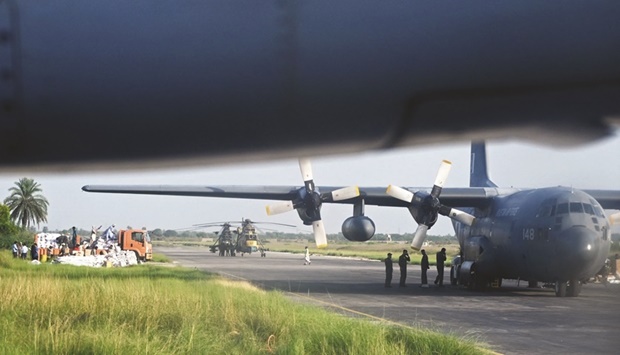Pakistani authorities are fighting to prevent the country’s biggest lake bursting its banks and inundating nearby towns after unprecedented flooding, while the disaster management agency yesterday added further 24 fatalities to its death toll.
Record monsoon rains and melting glaciers in Pakistan’s northern mountains have brought floods that have affected 33mn people and killed at least 1,314, including 458 children, Pakistan’s National Disaster Management Agency said.
The floods have followed record-breaking summer temperatures and the government and the United Nations have both blamed climate change for the extreme weather and the devastation it has brought.
The relief effort is a huge burden for an economy already needing help from the International Monetary Fund.
A delegation of three US lawmakers, who visited the flood-hit areas on Sunday to assess the damage and explore ways of assisting Pakistan in its recovery efforts, met Prime Minister Shehbaz Sharif yesterday, his office said.
Sharif told the lawmakers that given the challenges and enormous resources involved in the reconstruction efforts, “continued support, solidarity and assistance from the international community was critical,” the office said.
The UN has called for $160mn in aid to help the flood victims but Finance Minister Miftah Ismail said the damage was far higher.
“The total damage is close to $10bn, perhaps more,” Ismail said in an interview with CNBC. “Clearly it is not enough. In spite of meagre resources Pakistan will have to do much of the heavy lifting.”
Nevertheless, help kept pouring in with the foreign ministry reporting arrivals of relief flights yesterday from the United Nations and individual countries, including Turkmenistan and the United Arab Emirates.
Earlier, engineers breached Pakistan’s biggest freshwater lake to drain water threatening nearby towns, officials said yesterday, as heavy rain poured misery on millions affected by the country’s worst floods in history.
Nearly a third of Pakistan is under water — an area the size of the United Kingdom — following months of record monsoon rains that have killed 1,300 people and washed away homes, businesses, roads and bridges.
“There is nowhere to shower or go to the bathroom,” said Zebunnisa Bibi, sheltering near Fazilpur, in Punjab province, where 65 tents are now home to more than 500 people who fled their inundated villages for higher land.
Similar tent camps have mushroomed across much of the south and west of Pakistan, where rain has nowhere to drain because rivers are already in full flow as a result of torrential downpours in the north.
Sindh province Information minister Sharjeel Inam Memon told AFP yesterday that engineers had to cut a channel into Lake Manchar to drain water that was threatening the towns of Sehwan and Bhan Saeedabad, with a combined population of nearly half a million.
Still, thousands had to be evacuated from smaller settlements submerged by the newly directed channel.
“The flood water was diverted but the threat is still far from over,” Memon said.
“We are trying our best to stop the inundation of more villages.”
Lake Manchar, which lies west of the Indus River, varies in size according to the season and rainfall, but is currently spread over as wide an area as anyone can recall.
Much of Sindh and parts of Balochistan have become a vast landscape of water, with displaced locals huddled miserably on elevated roads, rail tracks and other high ground.
Human and animal waste in the fetid water attracts swarms of flies, while outbreaks of dengue are being reported from mosquitoes breeding in the swamplands.

Workers load relief food bags on a truck after unloading from a military plane for the internally displaced flood-affected people at the airport in Sukkur, Sindh province yesterday. (AFP)
